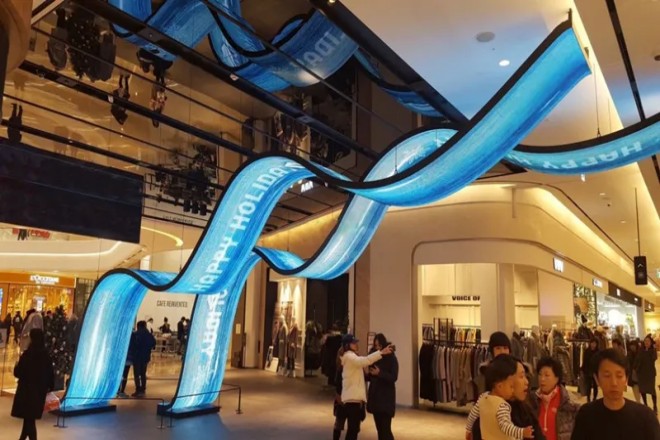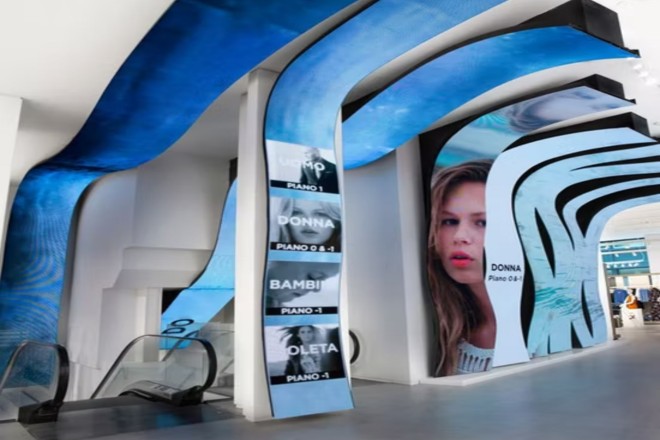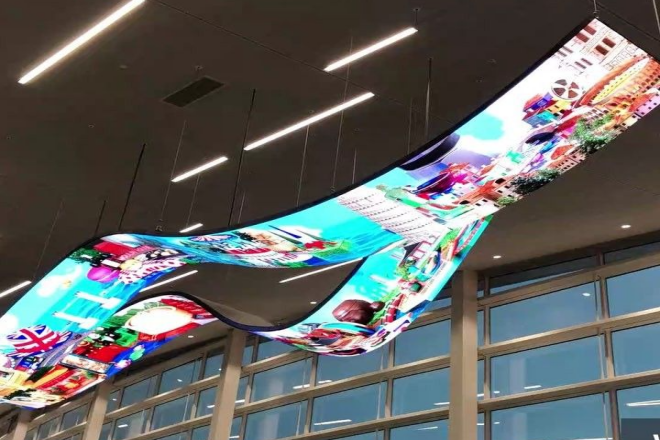介绍

柔性LED显示屏 are generally installed in wavy shapes, circular shapes, etc. So, are the video sources of flexible LED displays different? What are the requirements for video sources of flexible LED displays? This article will take you to explore it together.
1. What is the difference between the video source of flexible LED displays and that of ordinary LED displays?
Although both flexible LED displays and ordinary LED displays are display devices, their video sources are very different! The reason behind this mainly has to start with their physical properties, usage scenarios, and display effects.
- 解决 要求:
Flexible LED displays have a very high pixel density, just like a small screen filled with densely packed small light bulbs. In this way, the displayed image is particularly clear and delicate. Therefore, the video source equipped with it must also be high-resolution. Otherwise, the image will appear blurred, and details will be lost.
Generally speaking, the resolution of 1080p (1920×1080) is the starting price. If you want better results, 4K, 8K, or even higher-resolution video sources must also be considered. In contrast, although ordinary LED displays also require high resolution, they are not so picky.
After all, they are mostly used in outdoor advertising, large-scale events, and other scenes that are viewed from a distance, so moderate resolution is enough.
- Frame rate requirements:
When it comes to dynamic images, we have to mention the frame rate. The frame rate is the number of frames displayed per second. The higher the frame rate, the smoother the picture. Flexible LED displays are the ones that pursue extreme smoothness!
Especially when showing high-speed motion pictures, such as sports events and dynamic advertisements, the frame rate must be as high as 60 frames per second or even higher to ensure that the picture is smooth and not stuck.
Although ordinary LED displays also require high frame rates, they are not so strict. Usually, 30 frames per second can meet most application scenarios.
- Color gamut support:
Flexible LED displays have very strong color expression! The color range that can be displayed is particularly wide, just like moving all the colors on the rainbow to the screen. Therefore, the video source equipped with it must also contain wide color gamut information so as to make full use of the display’s color expression ability.
Wide color gamut standards such as sRGB, Adobe RGB, or DCI-P3 are all good choices. Although ordinary LED displays also support wide color gamut video sources, they are not so particular. Video sources using standard color gamut can meet the needs.
- Content adaptability:
Flexible LED displays are transformers! They can be bent and spliced into various shapes for the design of special-shaped screens.
In this way, the video source must have good adaptability and can be cut and adjusted according to screens of different shapes. Ordinary LED displays have fixed shapes and are mostly flat designs, so the requirements for adaptability of video sources are relatively low.
- Anti-blue light characteristics:
In some application scenarios, such as indoor exhibitions, commercial complexes, etc., flexible LED displays must also consider anti-blue light characteristics. After all, watching the screen for a long time is not good for the eyes, and the anti-blue light function can play a protective role.
Therefore, when choosing a video source, flexible LED displays may give priority to video files or players with anti-blue light functions.
Ordinary LED screens are mostly used in outdoor advertising, large-scale events, and other scenes. The distance between the audience and the screen is far, and the anti-blue light feature is not the main consideration.
- Dynamic video effect:
Speaking of dynamic video effects, flexible LED screens are the best! Because it supports high resolution, high frame rate, and a wide color gamut, the dynamic video played is particularly clear, smooth, and colorful.
In contrast, although ordinary LED screens can also play dynamic videos, they may be slightly inferior in clarity, smoothness, and color performance. However, in most cases, ordinary LED screens can still meet the basic dynamic video playback needs.
- 定制要求:
Finally, we have to talk about customization requirements. Flexible LED screens have diverse application scenarios and are often used for creative display and customized design.
Therefore, the video source may need to be customized according to specific needs, including customization of video content, adjustment of resolution and frame rate, and addition of special effects.
As for ordinary LED screens, their application scenarios are relatively fixed and mostly standardized, so the customization requirements of video sources are relatively low.
2. Basic requirements of flexible LED display for video source

Oh, when it comes to the flexible LED display, it is really full of technology, and the display effect is also top-notch!
However, if you want to show the best effect on this high-tech screen, you have to choose the video source carefully. Don’t worry; I will tell you in detail the basic requirements of a flexible LED display for video sources.
1). High resolution, clear and visible
Did you know? The pixel density of a flexible LED display is super high, just like countless tiny lamp beads are arranged closely together so that the displayed image will be delicate and clear. So, the video source must keep up with this rhythm, and the resolution must be high.
Generally speaking, the resolution of 1080p (1920×1080) is a starting price so as to ensure that the image will not appear blurry or lose details on the display.
Of course, if you have enough budget or have higher requirements for display effects, 4K, 8K, or even higher resolution video sources can also be considered. In this way, whether watching movies, playing games, or displaying advertisements, you can experience an unprecedented, clear visual experience.
2). High frame rate, smooth and not stuck
When it comes to dynamic images, we have to mention the word frame rate. Simply put, the frame rate is the number of frames displayed per second. The higher the frame rate, the smoother the picture. Imagine if you watch a movie and the picture is jerky, how uncomfortable it would be!
So, in order to make the dynamic images you see on the flexible LED display smooth and not stuck, the frame rate of the video source must also be high.
Generally speaking, 30 frames per second is a pass, but if you want better results, such as watching sports events or playing high-speed games, then 60 frames per second or even higher frame rates are your cup of tea. In this way, whether it is a fast-moving player or a fast-running car, it can be displayed smoothly in front of you.
3). Wide color gamut, more gorgeous colors
Speaking of color, it is really a highlight of the flexible LED display. It can display a very wide range of colors, just like moving all the colors of the rainbow to the screen. So, the video source must also keep up with this rhythm and contain wide color gamut information.
Here, wide color gamut standards such as sRGB, Adobe RGB, or DCI-P3 are all good choices. They can cover a wider range of colors, making the colors presented on the flexible LED display more brilliant, full, and real. In this way, whether you are watching movies, looking at pictures, or playing games, you can feel the colorful visual feast.
3. If the video source does not match, how can it be adjusted?

When the video source in your hand and the wavy flexible LED display are not so “in tune”, don’t worry, we have many ways to make them “coexist harmoniously”.
Next, let’s talk about how to adjust the video source to make it perfectly fit the wavy flexible LED display, so that you can understand and do it!
1). Shape adjustment:
The unique wave shape of the wavy flexible LED display is really eye-catching! But the video source is often flat; what should I do?
- Software to help:
Open your video editing software, such as Adobe Premiere Pro, After Effects, and other “great artifacts.” There are usually tools such as “deformation” and “distortion”.
We rely on them to “bend” the video and let it follow the waves of the screen. Remember to adjust it little by little until the video and the screen shape fit perfectly.
- Custom template:
Some playback systems are quite user-friendly and provide a custom template function. You can create a template according to the actual shape of the wavy screen and then drag the video source into it, and the system will automatically adjust it for you.
2). Resolution and clarity:
The wavy screen is close to the audience, so the video source must be clear enough!
Improve resolution: Find a higher-definition version of the video or try a video enlargement tool, such as Topaz Video Enhance AI, which can “enlarge” the video without losing too much quality.
Sharpen it: In the video editing software, find a “sharpen” function to add some “sharpness” to the video. In this way, the image will be clearer and the details will be more prominent.
3). Color and contrast:
The wavy flexible LED display has strong color expression, and the video source must keep up with the rhythm!
色彩校正: Use color correction tools, such as DaVinci Resolve, to adjust the color of the video. Make the color more accurate and more in line with your aesthetics.
Enhance contrast: The higher the contrast, the more layered the picture will be. In the video editing software, find the “contrast” option and pull it up, and the effect will be immediate.
4). Fluency:
For dynamic videos on a wavy screen, fluency is the key!
Increase the frame rate: The higher the frame rate, the smoother the picture. Find a video source with a high frame rate, or use software to “raise” the frame rate.
Optimize encoding: Choose a better video encoding, such as H.265, which has high compression efficiency and smooth playback.
5). Technical compatibility:
Don’t forget that the video source must be “matched” with the playback system!
Format conversion: Convert the video source to the format supported by the playback system. There are many free format conversion tools on the Internet, such as HandBrake and FFmpeg.
Parameter adjustment: Parameters such as resolution, frame rate, and refresh rate must all be based on the requirements of the playback system. Don’t be lazy, adjust them one by one!
6). Ask for help from experts:
If you can’t do it yourself, then find a helper!
询问供应商: Contact the supplier of the wave-shaped flexible LED display; they may have a ready-made solution or suggestion.
Ask a professional: Spend some money and find a professional video editor or technician to help. They are experienced and can solve problems quickly.
结论
In summary, creating a video source for a flexible LED display requires a careful combination of technical requirements and artistic creativity.
Through precise planning and production, we can not only give full play to the potential of the display, but also present an unprecedented visual feast for the audience.
最后,如果您想了解更多关于LED显示屏的知识, 请与我们联系。
